The 1950 season marked the beginning of a baseball revival on the prairies featuring a trio of unlikely nines.
A club from Sceptre, Saskatchewan (population 205) (a "whistle stop" for those who remember the era of passenger trains), a college team from California, the Mohawks, and an imported team from Florida, who became the Indian Head Rockets, highlighted the summer scene.
All three would be in the lineup for the first year of the Lacombe Lions Tournament, which quickly became recognized as one of the premier events on the summer calendar.

 Pete Beiden (left), baseball coach at Fresno State University and Roy Taylor (right), who would take over the baseball program at the College of Sequoias, were the architects of the barnstorming Mohawks who returned for a second season on the prairies. Beiden and Taylor would establish a pipeline to channel top college talent from the United States to Western Canadian teams.
Pete Beiden (left), baseball coach at Fresno State University and Roy Taylor (right), who would take over the baseball program at the College of Sequoias, were the architects of the barnstorming Mohawks who returned for a second season on the prairies. Beiden and Taylor would establish a pipeline to channel top college talent from the United States to Western Canadian teams.
Semi-pro ball had begun to take hold on the prairies.
In Manitoba, the Brandon Greys (coming off an incredible 1949 season in which they won 87, tied 3 and lost just 18 in 108 games) would be one of five teams in the new ManDak League. The Western Canada League was still a year away, but the Saskatoon and District League was underway with the legendary Delisle Gems winning the championship.
 A Toronto import, Doug "Goose" Gostlin was a key producer for the Gems. The newspaper The Globe and Mail noted Gostlin's terrific season in Saskatchewan, saying the right-hander had finished with a record of 20 wins and just four loses. We've been able to track down a record of 14-3 (with one, 11-inning, 1-1 tie). In one effort, he had a no-hitter for 8 and 2/3s but ended up losing.
A Toronto import, Doug "Goose" Gostlin was a key producer for the Gems. The newspaper The Globe and Mail noted Gostlin's terrific season in Saskatchewan, saying the right-hander had finished with a record of 20 wins and just four loses. We've been able to track down a record of 14-3 (with one, 11-inning, 1-1 tie). In one effort, he had a no-hitter for 8 and 2/3s but ended up losing.
Towns near the American border already had a strong tradition of mostly amateur baseball and eight teams lined up in the Southern Baseball League -- Estevan Maple Leafs, Regina Red Sox, Moose Jaw Canucks, Weyburn Beavers, Notre Dame Hounds, Lumsden Royals, Regina Caps, and Wilcox Cardinals. There were so many teams -- thirteen -- in the Northeastern Saskatchewan loop they had to set up three divisions.
Alberta saw the demise of the Big Four, but smaller Alberta communities would begin to turn stubble fields into baseball diamonds.
With stadium lights still a novelty, there were few night games on the prairies and weather conditions were often far from ideal. California Mohawks got a real taste of the prairies when one contest was called because of rain AND dust.
 This season, Western Canada baseball would groom three players -- Tom Alston, Pumpsie Green (left) and John Kennedy -- who would be the first black players on three of the major league teams -- St. Louis Cardinals, Boston Red Sox and Philadelphia Phillies.
This season, Western Canada baseball would groom three players -- Tom Alston, Pumpsie Green (left) and John Kennedy -- who would be the first black players on three of the major league teams -- St. Louis Cardinals, Boston Red Sox and Philadelphia Phillies.
There were a few prominent American imports. Truman Clevenger, who appears to have joined the California Mohawks for part of their tour, suited up late in the season with the Regina Caps. College All-American Lloyd Jenney was prominent in the Big Four, Charlie Peete in the ManDak League and Bennie Griggs in Saskatchewan.
Tournaments became the rage. Sceptre became a very recognizable baseball power. They would be the tournament kings taking home a reported $17,000 in prize money.
The Blackie baseball team is looking for good pitchers. They'll pay $150.00 per month at least. More if you are good enough. They tell us in Regina, that Brandon baseball Greys have a $6,000 a month pay roll. Not bad. [Time Out with Bruce Hogle, Medicine Hat News, April 25, 1950]
Don Pilling of the Lethbridge Herald chronicled the growth and offered views on the quality of baseball on the prairies :
... Scotty Munro is back home after undergoing a leg operation ... After he left the hospital in Regina he took in a few of the big-money tournaments in Saskatchewan and says the brand of ball is twice as good as they played in Southern Alberta and better than the Alberta Big 4 variety. He says teams like Sceptre, Indian Head, Swift Current, Delisle, Regina and Estevan look like good pro clubs. "They're playing more baseball in Saskatchewan now than ever before and the fans are gobbling it up faster than the games come along." "Imagine ... they had 10,000 people to see the final game of the Indian Head tournament." (Lethbridge Herald, August 4, 1950)

 The early 50s brought a flood of former Negro Leaguers into a new circuit, the Manitoba-Dakota (ManDak) League.
The early 50s brought a flood of former Negro Leaguers into a new circuit, the Manitoba-Dakota (ManDak) League.
Willie Wells, "Double Duty" Radcliffe, and Leon Day were among the black stars to suit up in Winnipeg (two teams), Brandon, Carman and Minot, the lone American club.
Even Satchel Paige (above left) made an appearance (see ManDak snapshots). Players from pre-Castro Cuba barnstormed across the prairies as the Florida Cubans then settled down to play as the Indian Head Rockets. In Ontario, Ted Alexander (above right) was among the former Negro League players to travel north of the 49th Parallel.
It is doubtful if any Saskatchewan baseball fans will have a look at old Satchel Paige this summer. The Satch's terms are a bit too high for the average club operator. All he's asking is a cool $500 per inning. At least that's the terms his agent quoted to John Ducey of Edmonton. At that tariff, Ducey figured he'd have to charge $3 per ticket to bring Paige to his Edmonton park. He didn't book the aging colored star. (Saskatoon Star-Phoenix, June 3, 1950)
The 1950 Regina Caps ran away from the pack in breezing to their third successive Southern League pennant. Still jinxed by a lack of playoff success, the Caps this time ran into severe financial problems as the regular schedule concluded. On top of that, the Caps were forced out of their playing venue at Taylor Field when the Roughriders football club eliminated the bleachers set aside for viewing baseball. The events led owner Cliff Ehrle to disband the club.

 Once the playoff dust had settled, the fourth place Estevan Maple Leafs prevailed by downing the Moose Jaw Purity Canucks four games to one. The import-laden Maple Leafs were a complete makeover from the Estevan unit that had begun the season and simply overmatched the Moose Jaw squad which was relying on a number of junior-aged callups to fill in a shorthanded roster. Individually, Claude "Shuffles" Williams (left) was the league's top hitter. The Regina Caps' first baseman swatted the ball for a .413 success rate and also led the circuit with 45 hits and 29 runs batted in. Moose Jaw playing-manager Mike Mellis (right) had a 7 - 1 mark on the hill to take the pitching honors,
Once the playoff dust had settled, the fourth place Estevan Maple Leafs prevailed by downing the Moose Jaw Purity Canucks four games to one. The import-laden Maple Leafs were a complete makeover from the Estevan unit that had begun the season and simply overmatched the Moose Jaw squad which was relying on a number of junior-aged callups to fill in a shorthanded roster. Individually, Claude "Shuffles" Williams (left) was the league's top hitter. The Regina Caps' first baseman swatted the ball for a .413 success rate and also led the circuit with 45 hits and 29 runs batted in. Moose Jaw playing-manager Mike Mellis (right) had a 7 - 1 mark on the hill to take the pitching honors,
 Brandon Greys won the ManDak pennant, winning 32 of 48 league games, but were ousted in the final by the Winnipeg Buffaloes. In a dramatic finish to the inaugural ManDak season, Buffaloes won the final game 1-0 in 17 innings as Leon Day went the distance for the win. Jim Newberry was a playoff star for Winnipeg. In just over a week he won four games and saved another allowing just three earned runs over 24 2/3s innings. He gave up only 15 hits while fanning 25 and walking four. He finished with a playoff ERA of 1.09.
Brandon Greys won the ManDak pennant, winning 32 of 48 league games, but were ousted in the final by the Winnipeg Buffaloes. In a dramatic finish to the inaugural ManDak season, Buffaloes won the final game 1-0 in 17 innings as Leon Day went the distance for the win. Jim Newberry was a playoff star for Winnipeg. In just over a week he won four games and saved another allowing just three earned runs over 24 2/3s innings. He gave up only 15 hits while fanning 25 and walking four. He finished with a playoff ERA of 1.09.

 Butch Davis of Winnipeg Buffaloes led the hitters with a lofty .456 mark, well ahead of runnerup Rafe Cabrera (.374).
Butch Davis of Winnipeg Buffaloes led the hitters with a lofty .456 mark, well ahead of runnerup Rafe Cabrera (.374).
Art Hunt of Brandon topped the pitchers with a 9-0 won-lost record.
The 1950 ManDak All-Stars, as selected by the Winnipeg Tribune, featured five players each from Brandon and Winnipeg :
Catcher - Ramon Rodriguez, Brandon, First base - Lyman Bostock, Winnipeg, Second base - Johnny Kennedy, WInnipeg, Third base - Ian Lowe, Brandon, Shortstop - Rafe Cabrera, Brandon, Left field - Lomax (Butch) Davis, Winnipeg, Centre field - Sol Drake, Elmwood, Right field - Jack Shaeffer, Carman, Utility - Leon Day, Winnipeg, Pitchers - Dirk Gibbons, Brandon; Art Hunt, Brandon; Taylor Smith, Winnipeg; Gentry Jessup, Carman, Manager - Wilf (Lefty) Lefevbre, Minot
From the Brandon Sun at the beginning of the 1950 season:
First and foremost, playing manager Ian Lowe was signed, and the return of the popular leader and hard hitting infielder will be applauded all over the circuit. Few pilots are in such high favor as the Brandon manager, for the quiet but efficient manner in which he handles his duties, earns him respect from rival clubs and fans as well.

 Barnstorming teams had become a summer staple on the prairies filling ball yards in centres large and small.
Barnstorming teams had become a summer staple on the prairies filling ball yards in centres large and small.
(George Anderson, left, and Doc Tally, right, two of the mainstays of the House of David).
The downward spiral of the Negro Leagues (following the integration of professional baseball) provided Canadian teams with an even larger pool of potential talent..
"George Ligon and his Negro Stars, who come from California in a bus with Texas plates, are back for the fifth straight year ... billed against the (Regina) Caps tonight.
On Monday, Caps have a date with Muskogee Cardinals, another touring club. Next Friday and Saturday, Nick Pappas has booked the House of David and Harlem Globe-Trotters for an all-tourist show and on the following Wednesday ... Caps will appear against San Francisco Sea Lions." (Tom Melville, Regina Leader-Post, June 17, 1949)
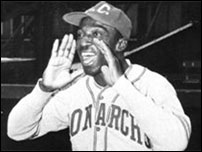 It took the touring clubs a couple of years after the Second World War to resume their town-hopping tours. When the House of David and the Kansas City Monarchs (KC's Cool Papa Bell, left) hit Regina in 1948, it was their first visit since before the war.
It took the touring clubs a couple of years after the Second World War to resume their town-hopping tours. When the House of David and the Kansas City Monarchs (KC's Cool Papa Bell, left) hit Regina in 1948, it was their first visit since before the war.
Interest in baseball skyrocketed.
"Baseball's popularity in Regina hit a new high Wednesday night when the biggest throng in several years (over 1,400 paid) turned up at Taylor Field to see Cliff Ehrle and his Caps nosed out 6-5 by the colored Muskogee Cardinals, first touring team to appear this summer." (Regina Leader-Post, June 10, 1948)
![]() The papers of the day made it clear that some of these touring teams were "different". (Regina Leader-Post, June 23, 1948)
The papers of the day made it clear that some of these touring teams were "different". (Regina Leader-Post, June 23, 1948)
"When bigger and better ball parks are built in Regina, the effervescent House of David and Kansas City Monarchs will probably fill them. They gave Taylor Field some to remember them by Tuesday night and brought back nostalgic memories of pre-war days as 3,500 customers (paying variety) stormed the gates, spewed over from the bleachers down the base lines and into deep centre field. It was almost a mob scene that greeted touring baseball's top-drawer clubs." (Regina Leader-Post, June 23, 1948)
"The crowd made more news than the ball game as almost 3,500 paid turned out for the second night in a row, a situation that astounded even the tourists who have run into fan enthusiasm in their time. They left for Swift Current and points west beaming over the success of their Regina ventures." (Regina Leader-Post, June 24, 1948)
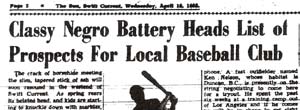 In Swift Current, the local paper highlighted the colour aspect of the game in noting the likely pitcher - catcher combination for the team would be Edward Lee Crowder and catcher Joe Webb.
In Swift Current, the local paper highlighted the colour aspect of the game in noting the likely pitcher - catcher combination for the team would be Edward Lee Crowder and catcher Joe Webb.
Over the summer of 1950, about two dozen touring teams would travel the rough roads of the prairies.

 In 1950, Hal Price, 24-year-old left-hander, who pitched for Brandon and Elmwood in Manitoba in 1949, after suiting up with one of the touring clubs, was at Vero Beach, Florida, for spring training camp with the Brooklyn Dodgers.
In 1950, Hal Price, 24-year-old left-hander, who pitched for Brandon and Elmwood in Manitoba in 1949, after suiting up with one of the touring clubs, was at Vero Beach, Florida, for spring training camp with the Brooklyn Dodgers.
Born in Nebraska, Price made his home in St. Paul, Minnesota. He said he was encouraged to come to camp by Mel Jones, general manager of the St. Paul team, a Dodger farm club.
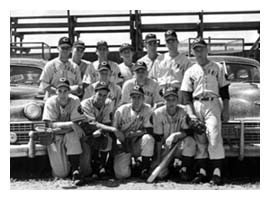 The California Mohawks would win games and fans as they zoomed from town to town across the West in their twin Chryslers.
The California Mohawks would win games and fans as they zoomed from town to town across the West in their twin Chryslers.
Some of those California kids discovered many of the Canadian teams offered a little hockey with their baseball. Lou Pisani, a member of the barnstorming California Mohawks came away impressed with the baseball talents of a few of the prairies hockey stars :
" ... Gordie Howe played first base and the Bentley brothers had their own field. They were good baseball players. You know how they used to slide into a base? You know in hockey they give you a shoulder? Well, they used to come in and roll. They didn't come in with spikes high, they'd come in, slide in, and roll into you with their shoulder and knock the ball out of your glove. They played hard, they were great guys. I also remember a mean winger, Bert Olmstead. If you fooled around with him, he'd take ya out."
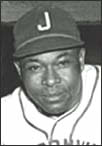 Indian Head, which had sponsored tournaments, decided to field a team of its own. Florida's Jacksonville Eagles, an all-Negro team, crossed the border, changed uniforms and voilà, the Indian Head Rockets were born. Jim Williams (left), a veteran of the Negro Leagues, was the club's manager.
Indian Head, which had sponsored tournaments, decided to field a team of its own. Florida's Jacksonville Eagles, an all-Negro team, crossed the border, changed uniforms and voilà, the Indian Head Rockets were born. Jim Williams (left), a veteran of the Negro Leagues, was the club's manager.
"The hard-hitting outfielder batted behind Josh Gibson and Buck Leonard for the Homestead Grays in 1938, rapping the ball for a .363 average ... he could run, hit, and hit with power ... the following season he moved to the Toledo Crawfords of the Negro American League, where, batting in the third slot for manager Oscar Charleston, his performance earned him a spot in the 1939 East-West All-Star game." (James A. Riley: The Biographical Encyclopedia of the Negro Baseball Leagues)
The Rockets featured such stars as Jesse Blackman/Blackmon, Jim Morrow and Louis Green. They had a highly successful first season winning their own tournament and taking home $9,000 in prize money.
Sceptre's George Mahaffy on Blackman/Blackmon. "The rumour we had was that Jesse had killed a man with an inside pitch. We didn't hit too well against him."
In a November meeting in Indian Head to discuss the team's performance, Jimmy Robison, chairman of the baseball committee, reported the team had played 91 games in Canada against 33 opponents. He said the Rockets had won 66, lost 20 and tied 5. [The Leader Post, November 7, 1950]
The Rockets strongly identified with the Saskatchewan town of Indian Head. In the fall of 1950 as the team settled back in Florida and prepared to meet a barnstorming team of major leaguers (including Roy Campanella, Don Newcombe, Luke Easter and Larry Doby) a Miami paper identified the club as from Saskatchewan.
 There's been no published explanation for why the Indian Head Rockets discarded outfielder Lincoln Boyd early in the 1950 season.
There's been no published explanation for why the Indian Head Rockets discarded outfielder Lincoln Boyd early in the 1950 season.
Boyd, who played with Brandon Greys in 1949 (hitting .,300 in limited time) and the Atlanta Brown Crackers, went on to join the Regina Caps and had a sensational season, hitting .436 while leading the league in triples and tying for the lead in home runs. He did not have enough at bats to qualify for the batting title.
A former Negro All-American halfback from Alabama A&M,
Boyd went on to play pro ball for a few seasons before disappearing from the public eye.
In 1955, with Clovis Pioneers in the West Texas - New Mexico League, hit .340 .447 .678 with 33 doubles and 44 home runs. The following season he set an incredible individual act with grand slam home runs in consecutive at bats, driving in a total of 11 runs in a 17-12 victory. There is no record of Boyd after the 1956 season.
It was the beginning of one of the prairies' great tournaments -- the annual event in Lacombe, Alberta. The California Mohawks made a big impression in the opening tourney with a dramatic semi-final victory. They split first prize money with Sceptre when rain prevented the championship game.
Stan Moher, Sports Editor of the Edmonton Bulletin:
"The lid really came off this town. Thousands poured in from points north, south, east and west.
One of the heftiest crowds ever to see an athletic attraction in this part of the province, an estimated 4,200 packed the bleachers of diamond B for the Lacombe-Sceptre semi-final. Roy Taylor, who homered dramatically in the ninth inning to give California Mohawks a squeak 6-4 win over Alaskan Command, is head baseball coach at College of Sequoias at Visalia, Calif.
Bigger and better is the slogan for next year's tourney. "Sure we'll be back," committee-chairman Jack Ferris promised at a late hour last night. Lacombe's prestige as a live-wire central Alberta centre received a big shot in the arm as a result of the successful promotion of their first tourney."
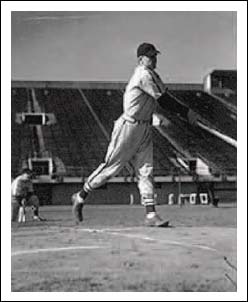 In 1950-51, the Oshawa Merchants of the Viaduct Major Baseball League, in the Toronto area, featured a future Nobel prize winner.
In 1950-51, the Oshawa Merchants of the Viaduct Major Baseball League, in the Toronto area, featured a future Nobel prize winner.
F. Sherwood Rowland, then known as Sherry, was the Oshawa playing manager, at age 21, while still a graduate student at the University of Chicago. The rag-tag club went on to capture the Canadian semi-pro title in 1950. In 1995 he was a co-winner of the Nobel Prize in Chemistry.
"The big discovery came in 1973 when he and post-doctoral student Mario Molina discovered that Right Guard was ruining the planet. Specifically, they figured out that chlorofluorocarbons (CFCs), chemicals then widely used as refrigerants and aerosol propellants, were eating away at the ozone layer in the upper atmosphere, exposing people to increasing amounts of cancer-causing radiation. It was a vital discovery. When Rowland was awarded the Nobel Prize in chemistry 21 years later for his part in making it, the award committee said that he may have "saved the world from catastrophe." And yet that discovery, in and of itself, will probably turn out to be only a minor part of Rowland's overall contribution to the future well-being of earth and its inhabitants." (How UCI chemist F. Sherwood Rowland saved the world (08.29.2002), University of Calfornia - Irvine)
The Sporting News reported that at least 36 former professionals from Organized Baseball were on the rosters of the eight teams in the Ontario Intercounty League.
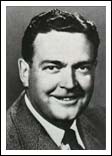 Edmonton's John Ducey (right) was at the forefront of the baseball resurgence.
Edmonton's John Ducey (right) was at the forefront of the baseball resurgence.
The 1950 season marked the end of his first major foray into baseball promotion in Edmonton. Ducey, who long had dreams of reviving the Western Canada League, which had flourished in the 20's, began in 1946 with a three-team loop in Edmonton (Cubs, Eskimos and Army & Navy Cardinals).
The experiment led to the development of the Big Four League with two Calgary teams -- the Buffaloes and Purity 99 from the Foothills League -- joining the Edmonton Cubs and Eskimos in the new circuit. It would last for four seasons.
The initial season, 1947, would coincide with an important milestone in the province, the beginning of the oil boom with the gusher at Leduc. The tough Purity 99s won the initial title defeating Ducey's Eskimos in six games.
The following season, Ducey brought it a veteran pro catcher to handle the club and the team responded with its only title. Eddie Morris, described as a 26-year-old, but who had started a pro career ten years earlier, would catch and coach the Eskimos over the 99s in the championship series. Morris stayed with the Eskimos for three seasons and later, in 1956, would turn up with the Lloydminster Meridians. One of the Purity recruits was a young Vulcan, Alberta schoolboy -- Glen Gorbous who would top his baseball career with time in the majors.
The Edmonton Cubs won in 1949 beating the Eskimos in the final.
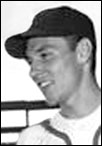 The 1950 season saw the Cubs drop out to be replaced by the Edmonton Dodgers (Don Stewart, later to be playing coach of the Meridians, would suit up for the Dodgers) under
The 1950 season saw the Cubs drop out to be replaced by the Edmonton Dodgers (Don Stewart, later to be playing coach of the Meridians, would suit up for the Dodgers) under  manager Jim Ryan. While the 99s would have Glen Gorbous (left) back in the lineup, the Eskimos signed a California collegian who would go on to play in the major leagues.
manager Jim Ryan. While the 99s would have Glen Gorbous (left) back in the lineup, the Eskimos signed a California collegian who would go on to play in the major leagues.
Bob Lillis (right) was the first of many stars from the University of Southern California to don the Eskimo pinstripes. Lillis won the batting title with a .409 average and his 10 homers tied Gorbous for the league lead. The Dodgers would take the league championship.
The Big Four folded after the 1950 season and Ducey would put his energy into an exhibition, barnstorming team, the Edmonton Oilers.
Veteran prairie hurler Hans Sagstuen hurled a no-hitter as Carmangay whipped Champion 11-0 in the final of the $1,000 Brooks Tournament. It was Sagstuen's fourth gem in his career having pitched two in Saskatchewan and another in London, Ontario.
While baseball was booming on the prairies, there was a danger sign -- television.
"The television virus which is spreading like wildfire through the United States is gradually infecting Canadians who are within range , says The Financial Post. At last count, 13, 500 Canadians had bought receiving sets. At an average price of around $200, they had dug down for a healthy $ 2 1/4 million. Canadian-built receivers are being produced by thirteen manufacturers. They had already made 5,300 sets this year. Estimates of production by the year-end range from 17,000 to 35,000 receiving sets. But all this is just "peanuts" compared to what many in the industry are sure is going to happen just as soon as the CBC or anyone else who is fortunate enough gets Canadian TV underway. They foresee an annual production of 200,000 sets; a new $100 million a year industry. If the CBC takes over this gigantic project , it's to be hoped that financing will be by some means other than by yearly license. " (The Claresholm Local Press, July 6, 1950 -- Subscription $3 per year, in advance)
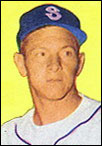 In 1950, another Canadian joined the ranks of major league players - Joe "Stubby" Erautt (born in Vibank, SK) hooked on with the Chicago White Sox for 16 games in each of the 1950 and 1951 seasons.
In 1950, another Canadian joined the ranks of major league players - Joe "Stubby" Erautt (born in Vibank, SK) hooked on with the Chicago White Sox for 16 games in each of the 1950 and 1951 seasons.
A 5'9" catcher, he was 28 when he made his MLB debut following seven years in the minor leagues, interrupted by three years of military service during the Second World War.
His best seasons were in the Southern Association with Little Rock where he hit .305 and .312 in 1948-1949.
